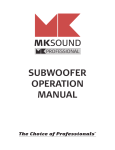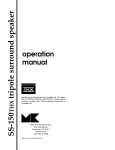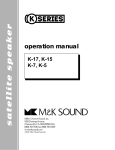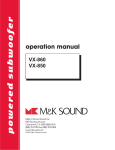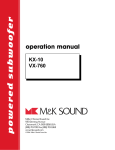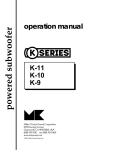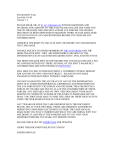Download MK Sound CENTER-850 Setup guide
Transcript
OPERATION MANUAL TABLE OF CONTENTS 1. INTRODUCTION..................................................……….................................................. 3 2. PLACEMENT OF YOUR SPEAKERS.......................…… ............................................... 3 3. SPEAKER HOOK-UP..............................................................…...................................... 3 4. OPTIMIZING SPEAKER PLACEMENT....................................…..................................... 4 5. THE TRIPOLE® SURROUND SPEAKER......................................……........................... 6 6. PLACEMENT OF THE TRIPOLE® SURROUND SPEAKER........…............................... 6 7. HOME THEATRE USAGE.................................................................…............................ 8 CENTER CHANNEL...................................................................…....................... 8 SURROUND CHANNEL............................................................…........................ 9 8. SATELLITE/SUBWOOFER PHASING TEST.............................................…..................10 9. PROTECTING YOUR SPEAKERS…………...............................................…...........….. 11 10. MK 5.1 MULTICHANNEL & PRO-LOGIC SYSTEM SETUP GUIDE.......…............... 12 11. CABINET MAINTENANCE............................................................................................ 14 Appendix A ..…………………………………………………………………………………. 15 Appendix B …………………………………………………………………………………… 17 DIAGRAMS FIGURE 1 SPEAKER WIRING.................................................................................…......... 4 FIGURE 2 SEPARATION BETWEEN LEFT & RIGHT SPEAKERS...........................…...... 5 SPEAKER PLACEMENT DIAGRAMS …………………………………..…..APPENDIX A 15 SPECIAL NOTES ON THE MK 150 SERIES ……………………….…….APPENDIX B 17 Please record the following information for your records: Serial Number: Date of Purchase: Dealer Name: Dealer Address: City/State/Zip: Country: Invoice Number: page 3 1. INTRODUCTION Congratulations! Your new MK speaker system will give you years of unmatched enjoyment and excitement while listening to your favorite musical and audio/video sources. We encourage you to read this owner’s manual, as there is a great deal of information provided here to help you achieve the best possible performance from your new speakers. If you have any questions about your speaker system, please contact your MK dealer. Additional information may also be obtained on our web site: www.mksoundsystem.com. This manual gives you basic hook-up instructions first, followed by more detailed and technical information 2. PLACEMENT OF YOUR SPEAKERS Your MK speakers can be installed in a wide variety of locations. Their compact size gives you great flexibility in installation. They can be placed on shelves, bookcases, or more permanently mounted using brackets, through direct attachment to a wall, or with a ceiling suspension system. You can place the left and right speakers virtually anywhere in the room, but certain locations are better than others. In general, locate them away from obstructions that would interfere with the direct path from the speakers to your ears (such as walls, furniture, lighting, plants, etc.). Center channel speakers should be located close to the television screen (see Home Theater Usage on page 8). Your speakers will sound better when they are around ear height, or when angled towards your listening location. They sound better when they are not sitting directly on the floor. For more detailed information on placement of your speakers, see Section 4 (page 4) and Appendix A. 3. SPEAKER HOOK-UP Please follow these instructions carefully, to avoid any possible damage to the speakers or your amplifier, and to get the best possible sound. The sound quality of your speakers can be affected by the type of speaker wire that you use to connect them. While it is possible to use speaker wire as thin as 22 gauge (0.6 mm diam.) to hook your speakers up, we recommend using the largest diameter wire that you can. This means a minimum of 18 gauge (1 mm diam.). Over 10 feet (3 meter), you should use 16 gauge (1.3 mm diam.), and for more than 30 feet (9 meter), we recommend using 14 gauge (1.6 mm diam.) or heavier. Note: The smaller the gauge number, the thicker the wire. There is a wide variety of premium speaker cables available from a number of specialist manufacturers. We do not endorse any specific brand of premium cable, but we do recommend using the highest quality cable that fits your budget. Using better quality cables will improve the sound of your speakers. page 4 HOOKUP For each speaker, connect the Positive (+) lead from your amplifier or receiver to the RED (+) INPUT terminal and connect the Negative (-) lead from your amplifier or receiver to the BLACK (-) INPUT terminal. See Figure 1. 4. OPTIMIZING SPEAKER PLACEMENT The sound quality produced by your speakers can be significantly enhanced by careful attention to their placement. While we understand that you may not want to redesign your room to accommodate your speakers, coming as close as possible to the ideal placement will give you much better sound. The left and right channel speakers can be oriented either horizontally or vertically. The center channel speaker is designed for horizontal orientation (tweeter and woofer drivers next to each other), and may be angled (vertically) towards your listening position. Three factors are important in getting the best sound. They are: A. Height (or angle). B. Location away from room walls or reflecting surfaces. C. Separation between Left and Right speakers. A. HEIGHT (OR ANGLE) Your MK speakers will always deliver sound superior to conventional speakers, regardless of where you locate them. However, because they are designed for very fast and accurate transient response, they achieve even better sound quality, and the flattest frequency response when properly oriented relative to your ear. Ideally, the tweeters should be at the same height from the floor as your ears, when you are sitting in your main listening position. If you have the speakers mounted above or below this height, they sound their best when you angle the speakers so that the speakers are aimed at your ears when you are in the main listening position. page 5 B. LOCATION AWAY FROM REFLECTING SURFACES Your speakers should be located, whenever practical, away from walls, the floor, furniture, or any other reflecting surfaces. Do the best you can. Objects close to the speaker will reflect sound, and this reflected sound arrives at your ear slightly later than the direct sound. This delay is very slight, so instead of hearing an echo, you hear a “blurred” sound with less clarity that is not as sharp and distinct as it should be. This time delay also affects frequency response and sonic imaging. If the speakers are on a television set or shelves, locate them on the front edge, so there is no flat surface directly in front of them. If the speakers will sit close to walls or other large objects, leave as much space as possible between the speaker and the object. Ideally, your speakers will be several feet from the nearest surface, but in most rooms compromise is necessary. C. SEPARATION BETWEEN LEFT AND RIGHT SPEAKERS Here is a formula for achieving the ideal left to right stereo imaging. Think of a triangle formed by the locations of the Left and Right speakers and your listening position. Ideally, the subtended angle formed should be between 45 and 50 degrees. Roughly, this means that the Left and Right speakers should be separated by about the same distance that you are sitting back from the speakers. In other words, if the distance from your listening position to the point directly between the speakers is 10 feet (6 meters), place the speakers so their centers are 10 feet apart. See Figure 2, above. On Figure 2, the length of line A - B should be about the same as the length of line X - Y. (They may not seem to be the same in this diagram due to an optical illusion). page 6 Try to follow the formula as close as you can. You can fine tune the placement by listening to a source with an image (such as a vocalist) centered between the speakers. When listening in stereo (no Center Channel speaker), move the speakers closer together or farther apart in small increments until you hear the sharpest and most cohesive image in the phantom center. You may also want to angle (or “toe-in”) the speakers slightly. This often improves the sharpness of the stereo image, reduces room colorations, and provides a wider seating area. 5. THE TRIPOLE SURROUND SPEAKER ® MK’s exclusive Tripole® design is a new concept in surround channel speaker design, offering a new level of performance not possible with conventional speakers by combining the performance advantages of two different types of speakers. Think of it as a dipole surround speaker that includes a very high quality direct radiating speaker in the same cabinet. As a Tripole®, the front baffle drivers (direct radiator) operate full range. The side Dipole drivers also operate, so sound is radiated on three axis. This means that the speaker can simultaneously produce a directional stereo image in the surround channels and an enveloping sound that wraps around the listener. The directional qualities and stereo imaging may be preferred to direct radiating speakers for playing back the “split” (stereo) surround channels of 5.1 channel discrete digital recordings. On the back of the speaker is a label with an arrow. To properly install the speakers, make sure that the arrow printed on the back of each speaker is pointed at the front of your screen. The arrows will not be visible once the speaker is installed (see figure 7 in Appendix A.) The Tripole® design is also ideal for the back surround channel of a 6.1 surround channel system. If you have such a system, we recommend using two Tripole® surround speakers to reproduce this format. 6. PLACEMENT OF THE TRIPOLE SURROUND SPEAKER ® (See speaker placement diagrams in Appendix A in the back of this manual) MK surround speakers are designed to be oriented with the front tweeter closest to the listeners. When the speaker is mounted above the listeners’ heads, make certain that the tweeter on the front baffle is at the bottom. If the speaker is mounted below listeners’ heads, the tweeter should be at the top. Your Tripole speakers are designed to be used as surround sound channel speakers, playing Dolby Digital, DTS, DVD-A, SACD and other discrete digital, or Pro-Logic sources. The Tripole® surrounds will achieve excellent results in THX systems as well. The instructions given here apply to surround channel applications. Due to the Tripole® design, your surround speakers are less critical of placement than most speakers. They should be located high on the wall, to the sides or behind the listening position. They can be mounted on the back wall of the room. The Tripole® design radiates sound to the front and the rear of the room in addition to directly at the listeners. The usual installation will be mounted flush on the side or back wall of the room. When wall mounting is impractical or impossible, mounting the speakers on the ceiling can be an excellent solution. a. POSITION RELATIVE TO SEATING The surround speakers can be located either to the sides of or behind the seating position. For maximum enveloping quality, the surround speakers should be located directly to the left and to the right of the preferred seating position, See FIGURE 3 in Appendix A. If there are multiple rows of seats, then the surround speakers would then be located directly to the left and right of the geometric center of the listening area. See FIGURE 4 in Appendix A. page 7 If your surround speakers cannot be located exactly to the left and right sides of the seating area, it is better for them to be located slightly towards the back of the room, or on the back/rear wall behind the listening position, rather than in the front of the room. See FIGURE 5 in Appendix A. b. HEIGHT The surround speakers should be located relatively close to the ceiling. Placement above the listeners’ heads is important, preferably with the cabinet’s bottom at least two feet (60 cm) above a seated listener’s head. In fact, it is even better if the speakers are located above standing listeners’ heads, about 6-7 feet (180 – 210 cm) above the floor for times when listeners are standing or walking around the room. c. WALL LOCATION The surround speaker can be mounted on either the side walls or on the back wall, or even directly in a corner. They can be flush on the wall, on shelves, on brackets, etc. The Tripole’s® great flexibility makes it very forgiving of room placement that is less than optimum. The Tripole® will give you a combination of an enveloping sound with directionality. You will hear directional effects, and even imaging when the recording has these qualities. Yet at the same time you will also hear a diffuse sound from the Dipole drivers mounted on the left and right cabinet baffles. If the sound lacks the directionality you desire, point the front baffles directly at the main listening position. If the sound is too directional, angle the speakers towards the back wall or the side wall surface directly behind them. By reflecting sound behind the listening position, you may increase the sense of envelopment in the sound. d. USE OF MULTIPLE PAIRS OF SURROUNDS Some listeners prefer multiple pairs of surround speakers. In very large rooms, this may even be necessary. Also, some surround processors and receivers have both side and rear surround channel outputs. Multiple speakers can make a dramatic improvement and provide a broader and deeper surround effect. When using multiple pairs of surround speakers, a symmetrical installation pattern works best. For example, one pair could be mounted on the back wall of the room, mounted equidistant from the back corners, with the other pair mounted on the side walls of the room, equidistant from the same back corners. See FIGURE 6 in Appendix A. When using two pairs of Tripoles®, make sure that the speakers on the back wall have their arrows labeled “Point Arrow At Screen” pointed towards the center of the back wall. e. USE WITH SURROUND-EX AND OTHER 6.1 CHANNEL SYSTEMS When using Tripole speakers with a 6.1 channel system, we strongly recommend using two speakers to reproduce the back surround channel. These speakers should be mounted on the center area of the back wall of the room, symmetrical to the wall’s center line. See FIGURE 6 in Appendix A. Follow your processor or receiver’s instructions for proper calibration. page 8 7. HOME THEATRE USAGE LEVEL-MATCHING The factor most critical to achieving excellent Home Theatre performance is level-matching the three front, two surround channels and subwoofer. This is even more important than timbre-matching. We strongly recommend that you purchase a good Sound Pressure Level meter (In the US, the Radio Shack Sound Level Meter is available for less than about $50. Get the analog meter, not the digital) and use it to measure the output of the speakers when playing the test tones generated by your processor or receiver. Set the meter to the “C” weighting scale and “SLOW” response, using your amplifier or receiver’s internal noise calibration test, set the levels so that all channels measure the same level. Using a meter is an inexpensive way to be certain that your system is calibrated properly. WHENEVER POSSIBLE, DO NOT CALIBRATE LEVELS BY EAR! TIMBRE-MATCHING One of the most important factors in achieving excellent Home Theatre performance is timbre matching. On film soundtracks, specific sounds are often moved from left to right or from front to back in the room. When the speakers reproducing these sounds have dissimilar characteristics, there will be an audible discontinuity when the sound shifts from one speaker to another. Timbre-matched speakers have very similar tonal characteristics and sound, which come from three critical elements: similar or identical drivers; similar or identical crossovers; and similar or identical frequency response. In full M&K systems, these elements have been addressed. You can be assured that the system can achieve the full potential of multichannel sound. When you have a multichannel system, speaker placement becomes extremely important, as you will be balancing four or five (or more) speakers rather than two. The following guidelines are for a 5.1 channel system, but if you do not have a Center channel, the instructions for the other four channels still apply. CENTER CHANNEL The Center channel speaker in a multichannel system is the most important speaker in the system. This speaker often produces more output than the left and right speakers combined. This speaker should be of the highest possible quality, and as similar as possible in response and radiation pattern to the left and right speakers. Three identical speakers are best, unless the center channel is designed to work with a set of left and right speakers. It is also important to have as much amplifier power as possible for the Center channel. As a minimum, the three front channels should be identical in power output, but it is better if the Center channel has more. If you have less power in the Center channel, this will be the limiting factor in the total output capability of the system when watching and listening to video sources. The Center channel speaker should be located as close as physically possible to the television or projection screen, preferably just above or below the screen. If that is not possible, then just to the left or the right of the screen may be acceptable. page 9 If the television is not in the center of the room (or not centered between the Left and Right speakers), the Center channel speaker should still be as close as possible to the screen -- even if it is outside the left and right speakers (such as a TV located in a corner of the room outside the stereo spread of the left and right speakers). Good results can be achieved in unusual configurations when the Center speaker is as close as possible to the screen. The Left and Right front channel speakers in a Home Theatre system should be placed the same as the left and right speakers in a stereo setup. Some listeners, however, may prefer to reduce the distance between the left and right speakers to bring the size of the acoustic image closer to the size of the screen image. For example, with a 25” direct-view television, you would want the speakers closer together than you would with a 100” projector. One recommendation is to separate the speakers by 1.5 times the diagonal screen size; another is to place the left and right speakers to create a 45 degree angle with the main listening position. There is a great deal of latitude in this area, as it is one of personal preference (especially if you will listen to music without video). It is also preferred that the speakers be equidistant from the listening position. Equidistant usually means that when the center speaker is on top of the television, the left and right speakers will sit in front of the set (they will be farther from the wall behind the TV than the center speaker). Ideally, the speakers should be at the same height as the screen, but it is much more important that all three speakers be as close to each other’s height as possible. If the center is much higher or lower than the other speakers, the effect can be distracting. Angling, or toeing-in the speakers, to aim at the listening position often improves imaging. When using a Center channel speaker, you have extra flexibility in placing the left and right speakers, as the Center channel speaker will tie most dialog and effects directly to the screen. SURROUND CHANNELS You can achieve good performance with your surround speakers placed in a wide variety of room locations. In general, they should be either to the sides of or behind the main listening position, located higher than the listener’s heads. They can be mounted on either the side walls or on the back wall, flush to the wall, on shelves, on brackets, etc. The goal is to achieve an enveloping sound. The surround channels should seem to come from all around you, rather than seeming to come from behind you only or directly from a speaker. For non-THX surrounds, we recommend starting with speakers on the side walls of the room, two to three feet (60 – 90 cm) above the listeners’ heads, either directly to the sides of the listening position or behind it. You can aim the speakers to fire towards each other (across the listening area), or you can aim them to fire towards the back wall at an angle. The surround speakers should not be in front of the main listening position if possible. If you mount the surrounds on the side wall behind the listening position, they can be aimed towards each other or angled towards the back wall or the side wall surface directly behind them. By reflecting sound behind the listening position, you may increase the sense of envelopment in the sound. If you want or need to mount speakers on the back wall of the room, there are several options. You can aim them so that they fire towards each other (so they fire along the back wall); you can aim them towards the front wall of the room; or you can angle them so they fire toward the side walls. Symmetrical arrangements work best. (Note: observe the arrows on the back of your Tripole speakers – see diagram 7 in Appendix A) page10 The speakers should be a minimum of a few feet away from the nearest listener. If the speaker is located too close to a listener, its sound will become too directional and may distract that listener. Ideally, the surround speakers should not call attention to themselves and should not be audible as separate sources of sound. If the surrounds must be located close to the listeners, aiming them at the room walls or even the ceiling can help to reduce any directional effect. As described above, this can produce a desirable result even in rooms where the surround speakers are an adequate distance from the listeners’ heads. If the surrounds cannot be placed on a wall, try placement on tables or the floor to the sides of the main listening position, firing up towards the ceiling. This can work very well in environments that do not allow permanent attachment of speakers to the walls. Some listeners prefer to use multiple pairs of surround speakers. While this is not necessary, it can provide a broader and deeper surround effect, with better coverage in very large rooms. When using multiple pairs of surround speakers, a symmetrical installation pattern works best. For example, if you are using two pairs of surround speakers for the surround channel, one pair could be mounted on the back wall of the room, mounted equidistant from the back corners, with the other pair mounted on the side walls of the room, equidistant from the same back corners. The surround channels can be installed in a wide variety of locations, but because they are usually mounted on the walls of the room, they can be a challenge to successfully install. If you have further questions, contact your M&K dealer or call us at the M&K factory. SUBWOOFER Subwoofer location for Home Theatre systems is essentially the same as for music systems. See our Subwoofer operation manual for more details. Remember to leave 2 - 3 feet (60 – 90 cm) of clearance between any television and subwoofer, unless the subwoofer is magnetically shielded. The preferred connection for the subwoofer is a subwoofer output from the amplifier or controller. This ensures that a full bass signal is being fed to the subwoofer. If you do not have such a subwoofer output jack, connect the subwoofer to the front Left and Right channel amplifier outputs (do not use the Center channel). When the Subwoofer is connected to the Left and Right amplifier outputs, and the controller is in Pro- Logic mode, the switch on the Pro-Logic control unit labeled Center channel WIDE/NORMAL must be set to the NORMAL mode. If the switch is set to the WIDE mode, the bass content of the Center channel will not be fed to the Subwoofer, and you will lose a significant amount of bass. 8. SATELLITE/SUBWOOFER PHASING TEST In any system using a subwoofer separate from Main speakers, a phasing test must be performed to ensure good bass blending. This test ensures optimum sound in the critical bass frequencies where your Subwoofer and Main speakers overlap. Play a familiar CD or DVD with steady, consistent bass content through your system. Listen carefully to the “mid-bass” region of 75 - 125 Hz. This is the part of the spectrum where electric or string basses and drums predominate. Then reverse the phase of either the subwoofer or BOTH Main speakers. If your Subwoofer has a PHASE switch on its back panel, move it either from (+) to (—) or vice versa. If your Subwoofer does not have a PHASE switch, it takes a bit more work. You will have to change the Positive and Negative speaker inputs on the back of BOTH Main speakers. page 11 You can do this at the back of both Main speakers, or at the Subwoofer’s TO SPEAKERS terminals, but never at both locations. The lead that was on the Positive (+) terminal should be switched to the Negative (—) terminal, and vice versa. As a safety measure, ALWAYS turn the amplifier off before making the switch. Now listen to the same musical passage as you did earlier, concentrating on the mid-bass region. If you hear less bass, the original connection (or switch position) was correct. If you hear more bass, the new connection (or switch) is correct. You need to perform this test because when Main speakers are located separate from a Subwoofer, each speaker is at a different distance from your ear. In some cases, the difference will be just enough so that the output from the Subwoofer arrives out of phase with the output of the Satellites. When this happens, that critical mid-bass is actually cancelled. You should re-do this test any time you move your speakers. If you want to experiment further, move the Main speakers either towards or away from your listening position, making changes in small increments. This will “focus” the system’s sound to its optimum. When you hear the best combination of stereo image localization and maximum impact and output in the mid-bass, you have the ideal location. 9. PROTECTING YOUR SPEAKERS An important factor to consider with any loudspeaker system is the potential for speaker damage. Even though your MK speakers have extremely high power handling capability (especially for Main speakers), they can still be damaged by relatively low powered amplifiers. While very few MK speakers are actually returned for service, the vast majority of those returned are not for manufacturing defects. Instead, they are returned because they have been over driven, almost always because the amplifier or receiver used was underpowered and was driven into clipping distortion. This damage is considered abuse, and is not necessarily covered under warranty. This clipping distortion occurs when the demands of the music are greater than the amplifier’s available power. It can occur at 20 watts with a small amplifier, or at 400 watts with a large amplifier. When this happens, the amplifier’s output waveform (which should look like a smooth arc) is “clipped” off, exhibiting a flat top instead of the arc. This “clipped” waveform contains multiples of the original amplified frequencies, sometimes at higher levels than the original signal itself. For tweeters, this can be very damaging, as this distortion is well above the audible range (where you are unable to hear it), and where the tweeter is most vulnerable to damage. When an amplifier “clips”, it generates a high level of high frequency energy (much higher than normal program material) which passes through the crossover to the tweeter. This energy can overheat the tweeter in a matter of seconds and destroy it. When this happens, the sound becomes harsh and grating, and a break-up is often audible in the bass frequencies. It will become uncomfortable to listen to, especially when compared to a slightly lower volume level. When you are listening at high volume levels, be aware of the onset of clipping distortion, and turn the volume down slightly if the sound takes on the character described above. When tone controls or equalizers are used to boost frequencies, the problem occurs much more rapidly. Even a small boost of low or high frequencies can easily double the power requirement and lead to amplifier clipping at moderate levels. Therefore, you should use your tone controls judiciously, avoiding extreme boosts of the bass and treble controls, especially when you are listening at high volume levels. page 12 The best way to avoid speaker damage is to use common sense. Use moderate boosts of tone controls or equalizers, at the very most. Listen carefully for any harshness and break-up, especially at high volume levels, and turn down the volume when needed. If you cannot get enough volume, you may need to consider a higher-powered amplifier. If you have any questions about this, please contact MK, and we will be happy to discuss it with you. 10. MK 5.1 MULTI-CHANNEL & PRO-LOGIC SYSTEM SETUP GUIDE The 5 Most Important Items In System Setup: 1. Find the best location for the subwoofer for maximum output and flattest response (usually the corner closest to the listening position) 2. Aim the front speakers (and the surrounds, if possible) for the flattest response and the best imaging 3. Set all speakers to the Small setting for proper High-Pass and Low-Pass Filter operation to get the lowest distortion and maximum dynamic range 4. Calibrate all speakers and the subwoofer to the identical level for proper imaging and balance 5. Make sure all speakers are in phase for proper imaging and impact These instructions will help you make sure that you cover all steps in setting up a 5.1 multi-channel or Pro Logic surround sound system. In addition to following this list, make certain that you study and understand the owner’s manual for each and every component used in the system, especially the processor/receiver’s manual. Have fun and good luck! A useful tool for system setup is the DVD called Video Essentials. If you don’t have one, you can order it by visiting the web site at www.videoessentials.com. Here are instructions for your speaker setup. 1. Locate the front speakers The left, right, and center speakers should be equidistant from the main listening position. Try to set up the speakers so that they are reasonably symmetrical to room surfaces. A tape measure may be very helpful. 2. Locate the subwoofer One of the best places for the subwoofer is the corner with the best structural strength. If the corners are roughly equal in construction, use the corner nearest the listening position. If the listening position is in the front half of the room, place the subwoofer in a front corner. If it is in the back of the room, place the subwoofer in a back corner. If possible, avoid corners near doorways or openings. If you are willing to experiment, another option is to place the subwoofer at the listening position and walk around the room. Stand in and near each corner. The location where you hear the tightest bass with the most impact is probably the best location in the room for the subwoofer. If multiple subwoofers are used, place them in the same location. Stacking is best, but you can also put them side by side. Another option for multiple subwoofers is to place them in different locations. This is appropriate when you have limited choices in locating the subwoofer and none of the available locations work well. Try to place multiple subwoofers at equal distances from the listening position to avoid phase cancellation. page 13 3. Locate the surrounds. Determine the best position in the room. It will probably be the position used for THX speakers, directly to the right and left of the main listening position on the side walls (so that a listener in the center seat is directly between the speakers). If that doesn’t work or is not practical because of the room, try these locations: on the ceiling; on the back wall. 4. Install all wiring and interconnects. 5. Connect the subwoofer. Always use the processor/receiver’s subwoofer (or LFE) output. 6. Aim the front left and right speakers in both the horizontal and vertical planes. Horizontal toe-in helps to get the best possible imaging. 7. If you have a Dolby Digital or DTS processor/receiver, follow these instructions. If you have a Pro Logic processor/receiver, go to item 8 below. SPECIAL NOTE: Always check the processor/receiver’s owner’s manual. Different manufacturers use different descriptions for the same function, and sometimes the same description for different functions! Your component may use terminology different from that used below. A. High-Pass Filters: All Dolby Digital processor/receivers have built-in high-pass filters for the Left, Center, Right, Left Surround, and Right Surround channels. Always turn these filters ON by using the SMALL setting. If you have a THX component, use the THX setting. See the owner’s manual of the processor/receiver for instructions. B. Bass Management: If the processor/receiver has a setting to turn the Subwoofer off or on, make sure that it is set to SUBWOOFER YES or ON. C. Dialog Normalization: If your component has this function, turn it off to avoid any possible effect on sound quality. D. THX Dolby Digital units have an adjustable limiter for the subwoofer feed, called “Bass Peak Level Management”. Turn it off, or set it for the highest possible level. M&K subwoofers do not need this limiter. 8. If you have a Pro Logic only processor/receiver, follow these instructions. SPECIAL NOTE: Always check the processor/receiver/receiver’s owner’s manual. Different manufacturers use different descriptions for the same function, and sometimes the same description for different functions! Your component may use terminology different from that used below. A. If the component has high-pass filters for the Left, Center, and Right channels (usually only THX components have these filters), they should be turned on or set to THX (if you have a choice, use the frequency closest to 100Hz - 120 Hz for Xenon series speakers. The surround channels in a Pro Logic only system do not have switchable filters. B. Set the center channel to Normal, unless you have a THX controller. With a THX controller, set the center channel to the THX setting. Appendix A Speaker Placement Diagrams: Figure 3 Figure 4 5.1 Surround Sound Side Wall Mounted Surrounds Figure 5 Figure 6 Figure 7 Back Wall Mounted Surrounds Multiple Surrounds Tripole Orientation Appendix B Special notes on the MK 150 Series: DO NOT REMOVE THE SPECIAL ACOUSTIC FOAM ATTACHED TO THE FRONT BAFFLE OF YOUR SPEAKERS. This foam is a critical part of your loudspeaker system and plays an important role in its high level of performance. It focuses the radiation of the tweeters, minimizes cabinet diffraction, and provides the flattest possible frequency response. Place your S-150 or MP-150 main speakers as shown in figure 1 below around a flat panel TV. You may also place your front three speakers (Left, Center and Right) either all above or all below the screen (see options in figure 3 below.) 12” (30 cm) max. Avoid turning your speakers on their sides (figure 2 below) as this will narrow the high frequency dispersion. The performance of your speakers is dependent on their orientation. By controlling the vertical dispersion, we limit the amount of sound that would otherwise be reflected with a time delay from the floor and ceiling. This means the speakers should always be vertically oriented. The MP-150 is vertically oriented when its tweeters are vertically stacked (not next to each other). When vertical, the controlled dispersion is in the correct plane. If they are oriented horizontally (on their sides), listeners right or left of a direct line from the center of the speaker will hear a compromised sound quality, an irregular frequency response, as well as some other problems. TV Figure 3 listeners’ optional front speaker placement around a flat panel Figure 4 Using flush mount brackets to mount the MP-150 on the wall MK Sound ApS · Denmark· Tel. +45 8619 8733 · www.mksoundsystem.com




















